Systematic analysis begins on Tappeh Borj findings

TEHRAN – A team of Iranian archaeologists has commenced an in-depth systematic analysis on Tappeh Borj, an archaeological site in northeast of the country.
Tens of experts of various historical periods are contributing to the survey which embraces the Neolithic, the Chalcolithic, the Bronze Age, prehistoric and Islamic eras as well, ILNA reported.
The survey covers some 13 ha of land and findings it had yielded before, the report added.
It is the initial stage of a long-term project being pursued [and carried out] by the University of Neyshabur under close supervision of the Research Center for Iranian Cultural Heritage Handicrafts.
Back in November, a human skeleton, which dates from some 5,500 years ago, was put on show at a museum of archaeology in Neyshabur. The skeleton was unearthed in 2004 while archaeologists were digging a trench in Tappeh Borj.
Neyshabur, situated 74 km west of Mashhad, has shifted its position repeatedly in historical times. American excavations in 1934–40 disclosed rich remains of both the Seljuq and pre-Seljuq periods in the locality.
AFM/MQ/MG
Leave a Comment